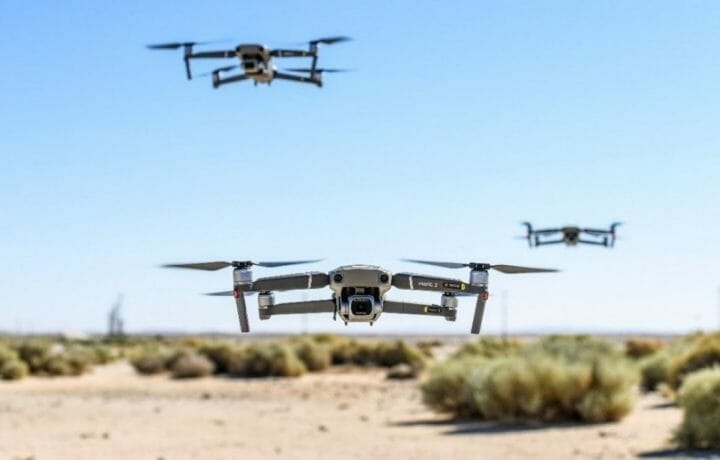This week, the United States Army kicked off its 2022 Experimental Demonstration Gateway Exercise (EDGE 22), which will run through May 12 near Salt Lake City at the Dugway Proving Ground. Whereas many of these exercises involve thousands of troops, a multitude of vehicles and equipment that often times needs to be trucked in on massive trailers, this one is involving far more compact – yet no less technical – aerial vehicles.
The Army is deploying some 30 tiny drones over the Utah desert as part of a networking test. The drones will be deployed from multiple sources including planes, ground personnel and even ground vehicles. Once launched, the drones will network together and fly toward and assault landing areas.
The Drones of War
The Ukrainian military has shown the potential that drones can play in actual combat, and since Russia launched its unprovoked attack in February, the Ukrainian forces have deployed drones to attack enemy tanks and armored vehicles. The small unmanned aerial vehicles (UAV) have also been used to conduct bomb damage assessment, and to provide targeting data for friendly artillery.
Video collected of successful combat strikes has even been widely shared on social media to show the world that Ukraine has become the masters of drone warfare.
Among the UAVs employed by Ukraine, the Turkish-made TB2, a 21-foot long vehicle that can autonomously take off and land with a full avionics suite onboard. It can fly at 18,000 to 25,000-feet for up to 27-hours. Its range is 185-miles. The TB2 has an auto-pilot feature – and the drone is not fully dependent on GPS – it has its own sensors.
Air-Launched Effects
The drones the United States Army is currently testing are significantly smaller in size and include a mix of Area-I’s small Air-Launched, Tube-Integrated, Unmanned System 600 (ALTIUS 600) and Raytheon-built Coyote drones.
It is the largest deployment of air-launched effects (ALEs) that the United States Army has already tested. ALEs are the various unmanned systems that can be launched from aircraft that can then be controlled by the aircraft crew or fly autonomously and feed information back to both the helicopter and networked ground troops. These drones will also be able to connect with the ground-based systems.
“What you’re going to see is an expansive use of electronic warfare and an expansive use of our interactive drone swarm,” Maj. Gen. Walter Rugen, head of the Army’s Future Vertical Lift Cross-Functional Team, told The War Zone in a recent interview. “We feel like we’re going to be flying the largest interactive drone swarm ever in partnership with DARPA and our science and technology experts out of Aviation and Missile Command.”
Ad Hoc Combat Network
With this current excise, the U.S. Army is now exploring ways to take the use of drones even further than what the Ukrainians have done. Moreover, this is likely just the first step in what could be a significant gamechanger for the future of combat operations.
“There are two trends that the United States military is now embracing, and which are being employed, that make drones such a viable platform: artificial intelligence and miniaturization,” said technology analyst and futurist Scott Steinberg.
“What we should expect in this, and similar tests, is how drones are becoming sophisticated enough to work together and to create a network of devices in real time,” Steinberg told ClearanceJobs.
Whereas drones have been used as a remote airborne system, where the operators can be hundreds or thousands of miles away, the future of drones will be autonomous and semi-autonomous platforms that can work together with far less interaction with a human operator. That doesn’t mean that these drone swarms will be unmanned flying terminators, but rather they can work with America’s warfighters.
The drones can provide intelligence on enemy troop movements, provide coordinates and even make sure that civilians or other non-combatants aren’t unnecessarily put in harm’s way. In other words, the drones can be the “eyes in the sky” but even more effective as part of an ad hoc network.
Specialized Drones
It is very safe to say that drones of all shapes and sizes could be employed by the military.
“These tests are being conducted to show how the smaller drones can work together,” Steinberg continued. “But we can expect to see a number of specialized drones developed for very specific missions. Already the U.S. Army, as well as the other services, is looking for some exponentially specialized drones – all of which can eventually be launched and networked together on the fly.”
Even after EDGE 22 concludes, the testing of the drones will continue this year – and the Army has also announced that drones will play a major role in the Project Convergence 2022, which will be held this fall at the Yuma Proving Ground, Arizona.
In addition to these exercises, it is likely that U.S. officials are monitoring how Ukraine will continue to utilize drones in combat.
“We have seen an underpowered nation that was attacked by a superior force, and it has been able to hold its own in part to the use of this type of technology,” Steinberg explained. “This has resulted in asymmetrical warfare that we haven’t seen to date. It is very likely that the age of the tank slugging it out on the battlefield is going to come to a close in our lifetime. The age of the drones is on the horizon.”




